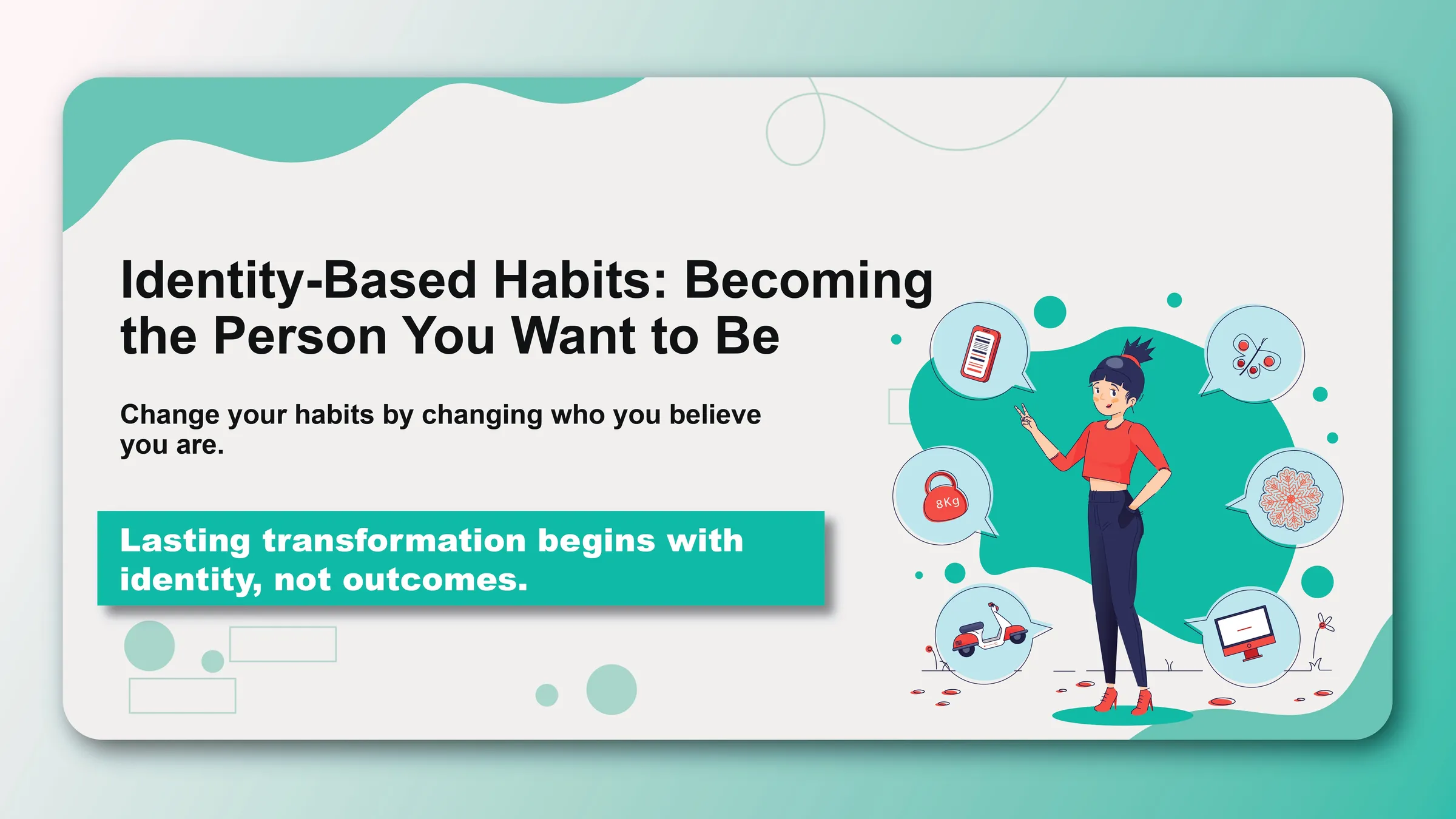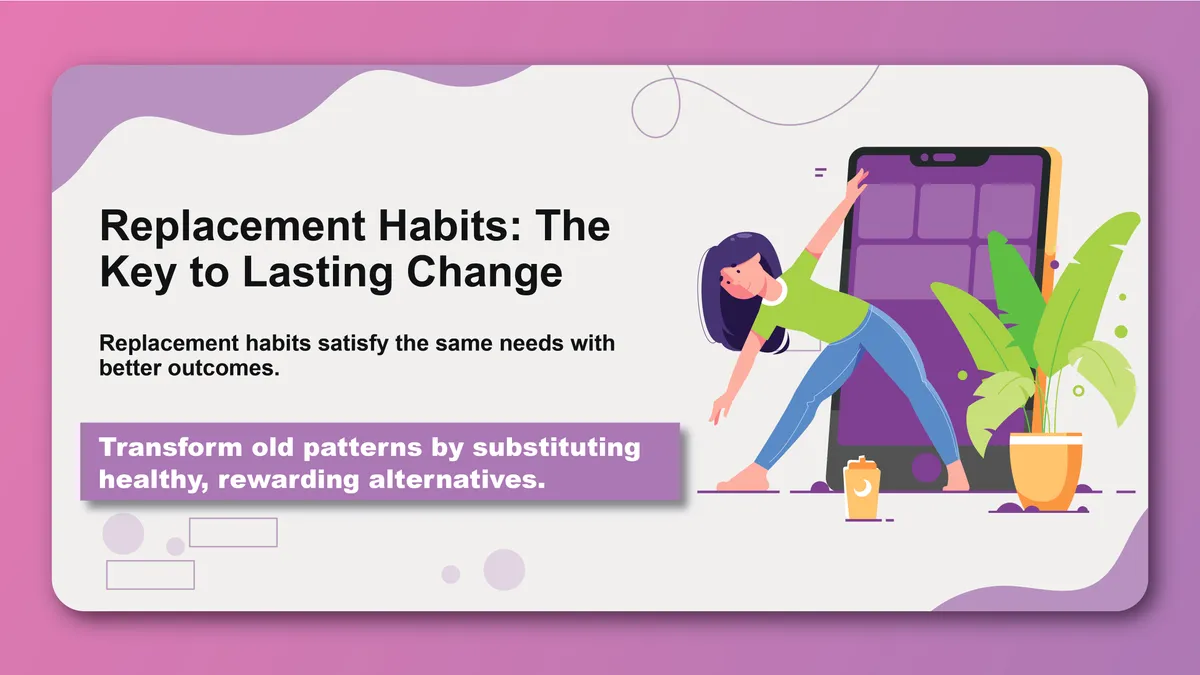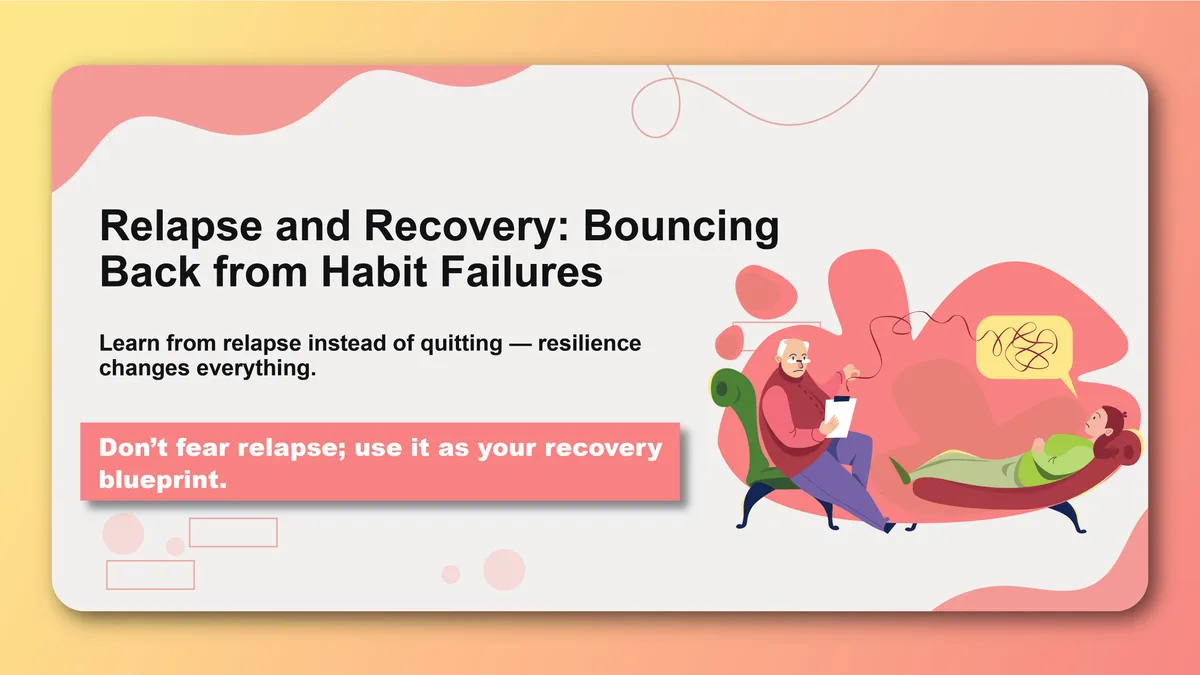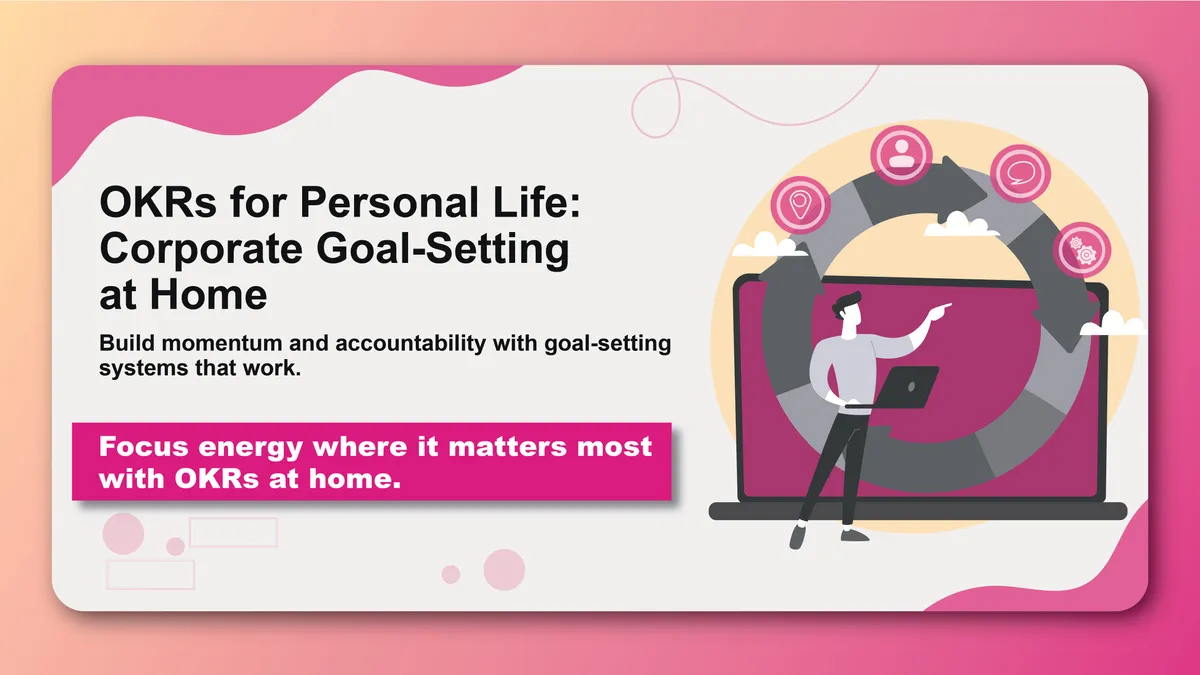Most people approach habit formation backward. They focus on what they want to achieve instead of who they want to become. This fundamental mistake is why 92% of people fail to stick with their new habits.
The secret to lasting change isn't better goals or stronger willpower—it's identity-based habits. When you focus on becoming the type of person who naturally does the behaviors you want, habit formation becomes effortless and sustainable.
In this guide, you'll discover how to transform your approach to habits by starting with identity, not outcomes.
What Are Identity-Based Habits?
Identity-based habits are behaviors that are driven by who you believe you are, rather than what you want to achieve. Instead of saying "I want to run a marathon," you say "I am a runner." Instead of "I want to write a book," you say "I am a writer."
This isn't just positive thinking—it's a fundamental shift in how you approach behavior change. When your habits align with your identity, they become automatic and effortless because they're consistent with who you believe you are.
The Three Levels of Change
Understanding the hierarchy of behavior change is crucial:
- Outcome-Based Change: Focused on what you want to achieve
- "I want to lose 20 pounds"
- "I want to read 50 books this year"
- "I want to learn Spanish"
- Process-Based Change: Focused on what you want to do
- "I want to go to the gym regularly"
- "I want to read every day"
- "I want to practice Spanish daily"
- Identity-Based Change: Focused on who you want to become
- "I am someone who takes care of my health"
- "I am a lifelong learner"
- "I am someone who embraces new cultures"
Most people start with outcomes and work backward. Identity-based habits start with identity and work forward.
The Science Behind Identity and Behavior
Self-Perception Theory
Psychologist Daryl Bem's self-perception theory suggests that we form our self-concept by observing our own behavior. Every action you take is a vote for the type of person you wish to become.
When you exercise, you're voting to be a healthy person. When you read, you're voting to be a knowledgeable person. When you meditate, you're voting to be a mindful person.
Cognitive Dissonance
Humans have a powerful psychological drive to remain consistent with their identity. When there's a mismatch between your identity and your behavior, you experience cognitive dissonance—an uncomfortable tension that motivates you to restore consistency.
This is why identity-based habits are so powerful: once you adopt an identity, your brain will work to maintain consistency with that identity through your actions.
The Identity-Behavior Loop
Your identity and behaviors reinforce each other in a continuous loop:
- Identity shapes behavior: Who you believe you are influences your actions
- Behavior reinforces identity: Your actions provide evidence for your beliefs about yourself
- Stronger identity drives better behavior: The more evidence you have, the stronger your identity becomes
- The cycle continues: Better behavior creates more evidence, strengthening identity further
How to Build Identity-Based Habits
Step 1: Decide Who You Want to Be
Before you can build identity-based habits, you need clarity on your desired identity. Ask yourself:
- What type of person do I want to become?
- What would someone with my desired identity do?
- What beliefs would this person have?
- How would this person approach challenges?
Examples of Identity Shifts:
- From "I want to get fit" to "I am an athlete"
- From "I want to be more productive" to "I am someone who manages time effectively"
- From "I want to learn to cook" to "I am a chef in my own kitchen"
- From "I want to be more social" to "I am someone who builds meaningful relationships"
Step 2: Start Small and Prove It to Yourself
Big changes in identity require evidence. You build this evidence through small, consistent actions. The key is to start with habits so small that they're almost impossible to fail.
The 2-Minute Rule Applied to Identity:
- To become a writer: Write one sentence per day
- To become a runner: Put on your running shoes and walk to the end of the block
- To become a reader: Read one page before bed
- To become organized: Make your bed every morning
These small actions provide evidence for your new identity without overwhelming you.
Step 3: Let Each Success Change Your Story
Every time you complete a small habit, you're collecting evidence for your new identity. The story you tell yourself about who you are begins to change.
Identity Reinforcement Process:
- Action: You write one sentence
- Evidence: "I wrote today"
- Identity shift: "I am becoming a writer"
- Stronger commitment: You're more likely to write tomorrow
- Better actions: You start writing more because "that's what writers do"
Step 4: Repeat Until the Identity Sticks
Identity change happens gradually through repetition. Each habit repetition is a vote for your new identity. The more votes you cast, the stronger your identity becomes.
The Voting Analogy:
- One workout: You're not an athlete yet
- Ten workouts: You're developing athletic habits
- One hundred workouts: You're becoming an athlete
- One thousand workouts: You are undeniably an athlete
The exact number doesn't matter—what matters is that you keep voting for the person you want to become.
Common Identity-Based Habit Examples
Health and Fitness Identity
"I am someone who takes care of my body"
- Micro-habits: Drink a glass of water upon waking, take the stairs, park farther away
- Language: "I don't skip workouts" instead of "I can't skip workouts"
- Decisions: Ask "What would a healthy person do?" before eating
Professional Identity
"I am a lifelong learner"
- Micro-habits: Read one page daily, listen to podcasts during commutes, ask one question in meetings
- Language: "I don't waste time" instead of "I don't have time"
- Decisions: Choose growth opportunities over comfort
Creative Identity
"I am a creative person"
- Micro-habits: Write one sentence daily, sketch for 2 minutes, take one photo
- Language: "I create daily" instead of "I want to be creative"
- Decisions: Prioritize creative work over consumption
Social Identity
"I am someone who builds meaningful relationships"
- Micro-habits: Send one text to a friend, compliment one person, ask one personal question
- Language: "I invest in relationships" instead of "I should be more social"
- Decisions: Choose connection over isolation
The Power of Identity-Based Language
The words you use to describe yourself have a profound impact on your behavior. Small changes in language can create significant shifts in identity.
Outcome-Based vs. Identity-Based Language
Weight Loss Example:
- Outcome-based: "I want to lose weight"
- Identity-based: "I am someone who takes care of my health"
Learning Example:
- Outcome-based: "I want to learn Spanish"
- Identity-based: "I am someone who embraces new cultures"
Productivity Example:
- Outcome-based: "I want to be more organized"
- Identity-based: "I am someone who creates order and clarity"
Reframing Common Statements
Instead of: "I'm trying to quit smoking" Say: "I'm not a smoker" or "I'm someone who values my health"
Instead of: "I'm bad with money" Say: "I'm learning to be financially responsible"
Instead of: "I'm not a morning person" Say: "I'm becoming someone who starts the day with energy"
Overcoming Identity Resistance
The Impostor Syndrome Challenge
When you start adopting a new identity, you might feel like an impostor. This is normal and actually a sign that you're growing. Remember:
- Everyone starts as a beginner: Every expert was once a novice
- Identity is practice: You become what you repeatedly do
- Small actions count: You don't need to be perfect to claim an identity
Dealing with Social Pressure
Your friends and family might resist your identity change. They're comfortable with the "old you" and might unconsciously sabotage your efforts.
Strategies for handling social pressure:
- Be patient: Give others time to adjust to your new identity
- Stay consistent: Don't let others pull you back to old patterns
- Find supportive communities: Surround yourself with people who support your new identity
- Lead by example: Show others what's possible through your actions
Working with Existing Identity
You don't have to completely abandon your current identity. Instead, evolve it:
Evolution, not revolution:
- Add new elements to your identity rather than replacing everything
- Find bridges between your old and new identity
- Celebrate the parts of your current identity that serve you
Advanced Identity-Based Strategies
The Identity Stack
Just as you can stack habits, you can stack identities. Choose complementary identities that reinforce each other:
Example Identity Stack:
- Core identity: "I am someone who lives intentionally"
- Supporting identities: "I am healthy," "I am organized," "I am a learner"
Identity Triggers
Create environmental cues that remind you of your identity:
- Visual reminders: Photos, quotes, or symbols that represent your identity
- Clothing: Dress in a way that aligns with your identity
- Space design: Organize your environment to support your identity
Identity Rituals
Develop rituals that reinforce your identity:
- Morning identity reminder: Start each day by stating your identity
- Evening identity review: Reflect on how you lived your identity today
- Weekly identity check-in: Assess your progress and adjust as needed
Measuring Identity-Based Progress
Identity Strength Indicators
Track how strong your identity is becoming:
- Consistency: How often do you act in alignment with your identity?
- Automaticity: How effortless do aligned behaviors feel?
- Recovery: How quickly do you return to aligned behavior after setbacks?
- Expansion: Are you naturally taking on more challenging aligned behaviors?
Identity Tracking Methods
Daily Identity Questions:
- Did I act like the person I want to become today?
- What evidence did I create for my new identity?
- How did my identity influence my decisions?
Weekly Identity Review:
- What actions strengthened my identity this week?
- Where did I act out of alignment with my identity?
- How can I better embody my identity next week?
Creating Your Identity-Based Habit Plan
Step 1: Define Your Core Identity
Write a clear statement of who you want to become:
- "I am someone who..."
- Keep it broad enough to encompass multiple behaviors
- Make it personally meaningful and inspiring
Step 2: Identify Supporting Behaviors
List specific actions that someone with your identity would take:
- What would they do daily?
- How would they handle challenges?
- What would they prioritize?
Step 3: Choose Your Starting Habits
Select 1-3 small habits that provide evidence for your identity:
- Make them so small they're almost impossible to fail
- Choose habits you can do daily
- Pick behaviors that feel aligned with your identity
Step 4: Create Identity Reinforcement
Design systems that strengthen your identity:
- Use identity-based language consistently
- Create environmental cues that remind you of your identity
- Celebrate actions that align with your identity
Step 5: Plan for Evolution
Your identity will evolve as you grow:
- Regularly reassess your identity
- Adjust your habits as your identity strengthens
- Add new dimensions to your identity over time
Common Identity-Based Habit Mistakes
Mistake 1: Choosing an Identity That's Too Narrow
Problem: "I am a marathon runner" is too specific Solution: "I am an athlete" or "I am someone who takes care of my body"
Mistake 2: Trying to Change Too Many Identities at Once
Problem: Attempting to become a writer, athlete, and entrepreneur simultaneously Solution: Focus on one core identity that can encompass multiple areas
Mistake 3: Setting Identity Standards Too High
Problem: "I am someone who never makes mistakes" Solution: "I am someone who learns from challenges"
Mistake 4: Ignoring the Evidence-Building Process
Problem: Declaring an identity without taking supporting actions Solution: Start with small, consistent actions that provide evidence
Mistake 5: Giving Up When You Don't Feel Like the Identity Yet
Problem: Expecting to feel like a writer after writing for a week Solution: Trust the process and focus on consistent action
The Long-Term Power of Identity-Based Habits
Compound Growth
Identity-based habits create compound growth:
- Stronger identity leads to better decisions
- Better decisions lead to better results
- Better results lead to stronger identity
- The cycle accelerates over time
Sustainable Change
Unlike outcome-based changes that fade when goals are achieved, identity-based habits are sustainable because they're part of who you are.
Flexible and Adaptive
Identity-based habits are flexible. When circumstances change, you can adapt your behaviors while maintaining your core identity.
Your Identity-Based Habit Action Plan
Week 1: Identity Design
- Define your desired identity: Write a clear statement of who you want to become
- Identify current evidence: What actions already support this identity?
- Choose starting habits: Pick 1-3 small daily habits that align with your identity
- Set up tracking: Create a simple system to track your identity-supporting actions
Week 2-3: Evidence Building
- Execute daily habits: Focus on consistency over intensity
- Use identity language: Speak about yourself in identity-based terms
- Make identity-based decisions: Ask "What would identity do?" before acting
- Celebrate alignment: Acknowledge when you act in accordance with your identity
Week 4-6: Identity Strengthening
- Expand behaviors: Add new actions that support your identity
- Handle setbacks: Return to identity-aligned behavior quickly after mistakes
- Adjust environment: Modify your surroundings to support your identity
- Seek community: Connect with others who share your identity
Week 7-8: Identity Integration
- Assess identity strength: How automatic do aligned behaviors feel?
- Plan for growth: What new challenges align with your identity?
- Expand identity: Consider adding complementary identity elements
- Teach others: Share your identity-based approach with others
Conclusion: Becoming Who You Want to Be
Identity-based habits are not just about changing what you do—they're about changing who you are. When you focus on becoming the person you want to be, the habits you want to build become natural expressions of your identity.
Remember:
- Start with identity, not outcomes
- Build evidence through small, consistent actions
- Use identity-based language consistently
- Be patient with the process
- Trust that small votes add up to big changes
The person you want to become isn't someone you'll meet in the future—it's someone you can start being today, one small action at a time.
Every habit is a vote for the person you want to become. What vote will you cast today?
Ready to build habits that align with who you want to become? Start your identity-based habit journey with Habityzer and track your progress as you transform into the person you've always wanted to be.



